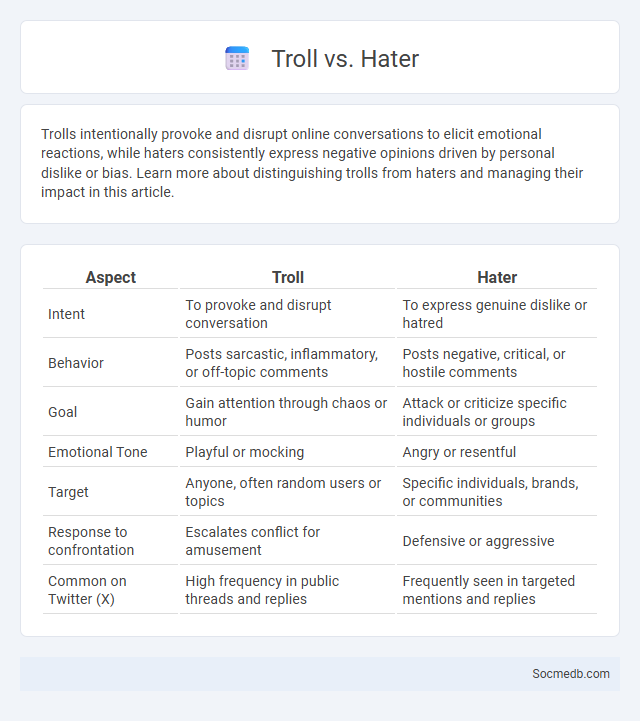
Photo illustration: Troll vs Hater
Trolls intentionally provoke and disrupt online conversations to elicit emotional reactions, while haters consistently express negative opinions driven by personal dislike or bias. Learn more about distinguishing trolls from haters and managing their impact in this article.
Table of Comparison
| Aspect | Troll | Hater |
|---|---|---|
| Intent | To provoke and disrupt conversation | To express genuine dislike or hatred |
| Behavior | Posts sarcastic, inflammatory, or off-topic comments | Posts negative, critical, or hostile comments |
| Goal | Gain attention through chaos or humor | Attack or criticize specific individuals or groups |
| Emotional Tone | Playful or mocking | Angry or resentful |
| Target | Anyone, often random users or topics | Specific individuals, brands, or communities |
| Response to confrontation | Escalates conflict for amusement | Defensive or aggressive |
| Common on Twitter (X) | High frequency in public threads and replies | Frequently seen in targeted mentions and replies |
Understanding Trolls: Definition and Characteristics
Trolls on social media are individuals who deliberately provoke, mislead, or upset others by posting inflammatory, off-topic, or irrelevant messages. Their characteristics include anonymity, persistence, and a desire to create conflict or disrupt conversations. Recognizing these traits helps you protect your online presence and engage more effectively in digital communities.
Who Are Haters? Key Traits and Behaviors
Haters are individuals who consistently express negative opinions or criticism toward people, ideas, or content on social media platforms. Key traits include frequent negativity, jealousy, and a tendency to provoke conflicts or undermine others' achievements. Their behaviors often involve posting hostile comments, spreading rumors, and engaging in online harassment to elicit reactions or assert dominance.
Troll vs Hater: Core Differences
Trolls seek to provoke reactions and disrupt conversations on social media by posting inflammatory or off-topic messages, while haters express genuine dislike or criticism toward specific individuals or content. Your ability to identify trolls involves recognizing their intent to create chaos without personal investment, whereas haters typically show consistent negative opinions rooted in personal bias. Understanding these core differences can help you manage and respond to online negativity more effectively.
Motivations Behind Trolling
Trolling on social media often stems from motivations such as seeking attention, expressing frustration, or testing social boundaries. Individuals may engage in provocative behavior to gain a sense of power or to influence online discussions negatively. Understanding these underlying motivations can help you develop effective strategies to manage and reduce troll interactions on your platforms.
What Drives Hater Behavior
Hater behavior on social media is primarily driven by anonymity, which reduces accountability and encourages more aggressive interactions. Psychological factors such as envy, insecurity, and the desire for social dominance also play a significant role in fueling online negativity. Algorithms that amplify sensational content further exacerbate hater behavior by rewarding engagement over constructive discourse.
Psychological Impact of Trolls and Haters
Social media trolls and haters can inflict significant psychological distress, including anxiety, depression, and lowered self-esteem in individuals exposed to their negative comments. Studies reveal that constant exposure to online harassment triggers stress responses and may lead to long-term mental health issues such as social withdrawal and increased feelings of loneliness. Protective measures, including digital literacy education and strong community guidelines, are essential to mitigate the adverse effects of toxic online behavior.
Trolls on Social Media: Tactics and Examples
Trolls on social media employ tactics such as spreading misinformation, provoking emotional responses, and disguising their identity to avoid accountability. Examples include orchestrated harassment campaigns, posting inflammatory comments, and using fake profiles to amplify negativity. Protecting your online presence requires recognizing these behaviors and employing tools like reporting features and privacy settings.
Haters in Online Communities: How They Operate
Haters in online communities often thrive by targeting individuals or groups with negative comments and harassment, aiming to provoke emotional reactions and disrupt discussions. They typically operate under anonymity or pseudonyms, using trolling, bullying, and spreading misinformation to exert influence and undermine community cohesion. Understanding their behavior patterns and communication tactics helps platforms develop more effective moderation strategies to maintain healthy, respectful interactions.
Dealing with Trolls and Haters: Effective Strategies
Dealing with trolls and haters on social media requires strategic responses like ignoring inflammatory comments, utilizing platform-specific blocking tools, and reporting abusive behavior to moderators. Engaging positively with your supportive community and maintaining a consistent brand voice helps mitigate negativity while preserving mental well-being. Implementing automated moderation bots and clear comment policies further ensures a respectful online environment.
Promoting Positive Online Interaction
Promoting positive online interaction on social media platforms fosters respectful communication and reduces cyberbullying, enhancing user experience and community trust. Implementing features like content moderation algorithms and encouraging digital literacy equips users to engage constructively. Social media companies investing in these strategies contribute to safer, more supportive virtual environments.
 socmedb.com
socmedb.com